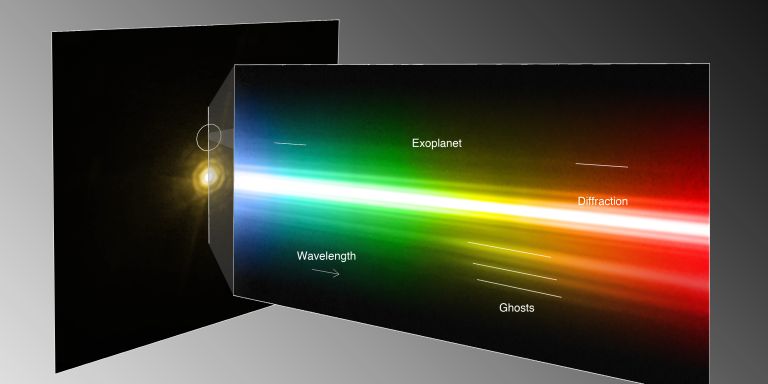
Markus Janson
Professor of Astronomy
Wallenberg Academy Fellow, prolongation grant 2018
Institution:
Stockholm University
Research field:
Exoplanets


Wallenberg Academy Fellow, prolongation grant 2018
Institution:
Stockholm University
Research field:
Exoplanets
“Is there life on other planets in the universe? That question is constantly at the back of my mind,” says Janson, who is a professor of astronomy at Stockholm University.
Janson researches on exoplanets, i.e. planets orbiting stars other than our own sun. The first exoplanets were discovered as recently as the mid-1990s. Before then it was uncertain whether other stars had planets.
A key impetus for the research into exoplanets is a desire to discover planets resembling Earth – that are as large and the same distance from a sun-like star as Earth is from the sun.
“As we look out into space, most of what we see is very different from Earth. We want to know how common planets reasonably similar to our own are. Since an Earth-like planet is the only place we know for sure that life can exist, this has a bearing on the question of life elsewhere in the cosmos.”
But it is not possible to detect Earth-like exoplanets with the telescopes currently available. As a Wallenberg Academy Fellow, Janson is pursuing two lines of research, which together may change all that.
“This grant offers flexibility, which is vital. I can pursue new ideas that arise, which gives my research a greater chance of success. The funding is also essential for me to conduct my research as I do – to have time myself for research, and to be able to employ PhD students and postdocs.”
One project is to develop and launch a research satellite. The aim is to detect potential Earth-like planets orbiting the two closest stars outside our solar system that resemble our sun: Alpha Centauri A and B. They are about four light-years from Earth.
“The satellite will be about the same size as a washing machine. We hope to launch it as part of the Swedish National Space Agency program for research satellites.”
The researchers are working with a company that is building the satellite, while they are developing the new technology it will carry. The technology must be able to register indirect signs that a planet exists – to be precise, the small movements of stars caused by the gravitational pull of a planet.
“The movement must be measured very precisely by the satellite. We’re making simulations to show that we can measure the position of the star accurately enough to determine whether or not there is a planet there.”
That information can then be used to determine the mass and orbit of any planets that are found.
The second line of research is to find planets using direct imaging. This means detecting light from the planet itself. The challenge here is to develop methods capable of distinguishing faint light from the planet from the much stronger light from the star it is orbiting.
The light from a planet is affected by molecules in its atmosphere. By measuring light from the planet, direct imaging therefore provides data on the composition of the atmosphere, which in turn has a bearing on its characteristics. The presence of oxygen molecules in the earth’s atmosphere, for example, is due to the existence of life on the planet.
About ten exoplanets have been found so far using direct imaging. Janson has been involved in several of these discoveries, the most recent of which was a planet that is still forming.
“It was a really exciting discovery. It means we can now focus on the processes involved when planets form.”
The discovery was made with the help of adaptive optics, a technology Janson worked with during his first period as a Wallenberg Academy Fellow. It was then that he also started a large-scale international study using direct imaging to find giant planets orbiting ultra-heavy stars. The studies are being performed at the Very Large Telescope (VLT) in the northern Chilean desert.
“Using current telescopes we can find giant planets and identify the methods that work best for detecting these very weak light signals from a planet. We can use the methods with new telescopes as they become available, to study smaller, much more Earth-like planets.”
One such new telescope for which Janson’s research team is developing technology is the James Webb Telescope, which NASA plans to launch into orbit in 2021.
Another is the Extremely Large Telescope (ELT), currently under construction near VLT in Chile. It will be the world’s largest terrestrial classical telescope, with a primary mirror almost 40 meters in diameter. The size of the mirror will enable astronomers to study planets that are smaller and fainter, and hence more similar to Earth, than is currently possible.
By the time his tenure as a Wallenberg Academy Fellow is over, Janson hopes that his team will have refined their methods sufficiently to enable them to use their research satellite to search for Earth-like planets, before imaging them with new telescopes.
“Ideally, we will have launched our satellite by then, and started to receive data on the Alpha Centauri system from it. And if there are planets there, that we will know how to image them. To put it simply – we hope to have reached a point where we can start to focus our research on Earth-like exoplanets, and begin to answer the big question – about life in the universe.”
Text Sara Nilsson
Translation Maxwell Arding
Photo Alexis Brandeker, Markus Janson, Mediabruket